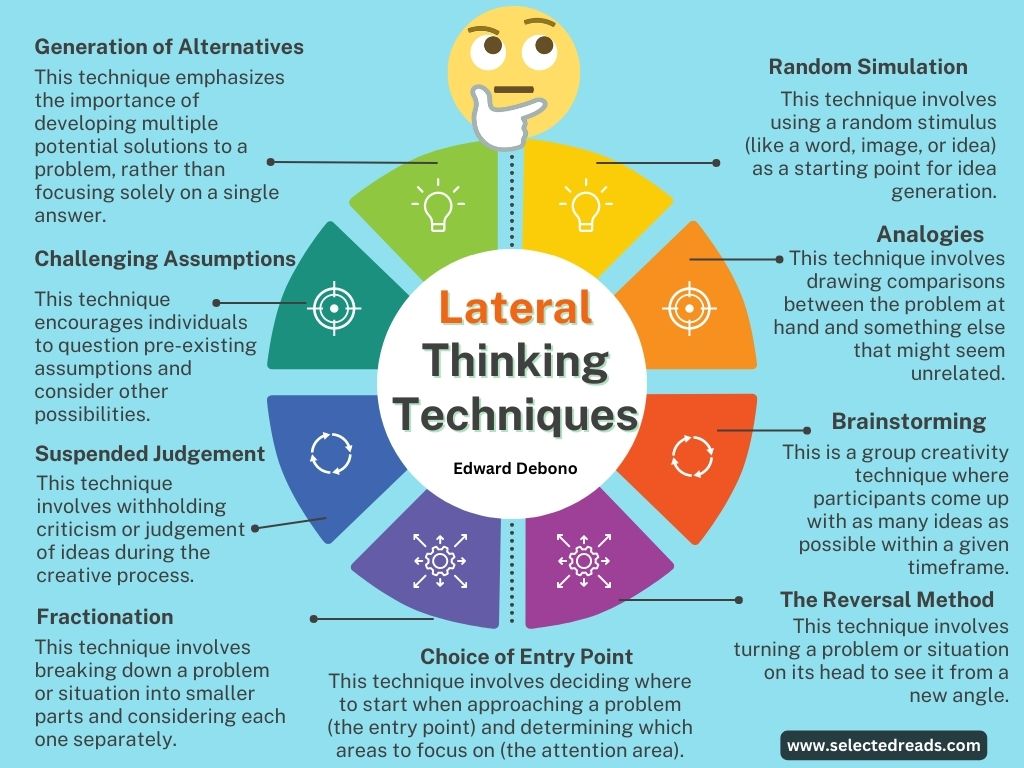I recently turned the last page of Edward de Bono’s influential book, “Lateral Thinking: Creativity Step by Step,” and I must say I really enjoyed this amazing read! De Bono’s unique approach challenged me to break free from my conventional thought patterns and I couldn’t wait to share my thoughts with you all, so let’s dive right in.
The whole premise of the book is centered around ‘lateral thinking,’ a concept quite different from our everyday ‘vertical’ thought process. While vertical thinking is systematic and logical (and trust me, there’s nothing wrong with that), lateral thinking dares us to jump out of that box. It’s like choosing to hopscotch instead of walk—jumping from one idea to the next, sparking creativity along the way.
Throughout my reading, I had several “Aha!” moments where I realized how I had been confining my thought process in rigid patterns. De Bono really brought it home that our minds can often become entrapped in familiar methods and solutions, hindering our creative potential. But with lateral thinking, we can combat this tendency and come up with fresh, innovative ideas.
Related: Key Lateral Reading Skills for Students
Lateral Thinking Techniques
De Bono shares various techniques to help implement this style of thinking, and a few really stuck with me:
- Generation of Alternatives: This technique emphasizes the importance of developing multiple potential solutions to a problem, rather than focusing solely on a single answer.
- Challenging Assumptions: Assumptions often limit our thinking and inhibit creativity. This technique encourages individuals to question pre-existing assumptions and consider other possibilities.
- Innovation: This is not so much a technique but an overarching goal of lateral thinking. By utilizing the various techniques, the aim is to come up with new, innovative solutions that might not have been discovered through traditional, linear thinking.
- Suspended Judgement: This technique involves withholding criticism or judgement of ideas during the creative process. It’s often used in brainstorming sessions to create an open, accepting environment that fosters creativity.
- Design: This refers to the intentional creation of ideas or solutions, as opposed to the spontaneous occurrence of inspiration. This technique encourages a proactive approach to problem-solving.
- Dominant Ideas and Crucial Factors: Dominant ideas are those that are most obvious or common, while crucial factors are elements of a situation that are particularly important. Identifying these can provide valuable insights when problem-solving.
- Fractionation: This technique involves breaking down a problem or situation into smaller parts and considering each one separately. This can often make complex problems more manageable and reveal new perspectives or solutions.
- The Reversal Method: This technique involves turning a problem or situation on its head to see it from a new angle. It’s about questioning why things are the way they are and considering what might happen if the opposite were true.
- Brainstorming: This is a group creativity technique where participants come up with as many ideas as possible within a given timeframe. The key is to encourage free thinking and suspend judgment.
- Analogies: This technique involves drawing comparisons between the problem at hand and something else that might seem unrelated. It can often spark new insights or ideas.
- Choice of Entry Point and Attention Area: This technique involves deciding where to start when approaching a problem (the entry point) and determining which areas to focus on (the attention area).
- Random Simulation: This technique involves using a random stimulus (like a word, image, or idea) as a starting point for idea generation.
- Concepts/Divisions/Polarization: This technique involves dividing a problem or situation into categories (concepts) or opposing pairs (polarization) to explore different perspectives or solutions.
Each of these techniques provides a different way to stimulate creative thinking and problem-solving. By combining and alternating between them, you can unlock a rich variety of innovative solutions and insights.
I’ve taken the time to create an intuitive, easy-to-understand poster that graphically represents these lateral thinking techniques!
This visual guide provides an at-a-glance reference to help you understand and apply these methods more effectively, whether in your classroom, team discussions, or even in your personal life. It’s designed with educators in mind, distilling the complexity of lateral thinking into engaging, digestible bites.
The poster below is available for free download exclusively for our subscribers.
Application of Lateral Thinking Techniques in Teaching
In the classroom, lateral thinking proves to be an incredible asset. As educators, we can use these techniques to encourage students to generate multiple solutions, challenge existing ideas, innovate, and explore different perspectives.
From facilitating brainstorming sessions to designing lessons that cater to students’ interests, these methods make learning more engaging and meaningful, fostering a rich, creative environment. Here are some examples of how these lateral thinking techniques can be applied in a teaching context:
- Generation of Alternatives: Encourage students to come up with multiple solutions to a problem in class. For instance, if you’re discussing environmental sustainability, students can brainstorm different strategies to reduce waste at school.
- Challenging Assumptions: During a history lesson, challenge the assumption that historical events could only have unfolded in one way. Ask students to consider what might have happened if certain factors had been different.
- Innovation: Assign a project where students have to come up with an innovative product or solution to a real-world problem. They could design a new gadget, create a community service, or develop a novel business idea.
- Suspended Judgement: During brainstorming sessions, create a safe space where all ideas are welcomed and none are criticized. This encourages more participation and creativity from students.
- Design: Instead of simply following the curriculum, design lessons that cater to students’ interests and passions. This can make learning more engaging and meaningful.
- Dominant Ideas and Crucial Factors: When discussing a novel or historical event, encourage students to identify the dominant ideas (themes, trends) and the crucial factors (key events, decisions) that shaped the outcome.
- Fractionation: Break down complex concepts into smaller, more manageable parts. For instance, when teaching a difficult mathematical formula, dissect it into parts and tackle each section individually.
- The Reversal Method: In a science class, instead of explaining why leaves are green (due to chlorophyll), ask students to think about what would happen if leaves were a different color.
- Brainstorming: Encourage brainstorming for group projects. Students can collaborate and bounce ideas off each other, fostering a rich, creative environment.
- Analogies: Use analogies to explain complex concepts. For example, compare the layers of the Earth to the layers of an apple to help students understand geological structures.
- Choice of Entry Point and Attention Area: For a research assignment, allow students to choose their own topic (entry point) and specific focus (attention area). This makes learning more personalized and engaging.
- Random Simulation: Introduce a random topic (e.g., “penguins”) and ask students to connect it to the current subject of study. This can lead to interesting discussions and new insights.
- Concepts/Divisions/Polarization: For a social studies lesson, divide a societal issue into various concepts (e.g., economic, cultural, political aspects) or opposing views for debate.
Limits of Lateral Thinking
While lateral thinking is a powerful tool for generating creative solutions and ideas, it does have its limitations. Understanding these can help ensure that the technique is used effectively:
- Lack of Structure: Lateral thinking, by its very nature, is less structured than conventional, linear thought processes. This can make it challenging to use, especially for individuals or teams who are accustomed to more traditional, logical, and organized methods of problem-solving.
- Time and Resource Intensive: Lateral thinking can be time-consuming. Generating a wide array of ideas and exploring different perspectives and possibilities takes time. It also requires a willingness to tolerate ambiguity and uncertainty, which some people may find uncomfortable.
- Quantity Over Quality: Lateral thinking emphasizes the generation of numerous ideas, with the belief that this will lead to a few quality ideas. However, this is not always the case, and it can sometimes result in a large number of ideas that are unfeasible or irrelevant.
- Risk of Straying Too Far: While the purpose of lateral thinking is to encourage out-of-the-box thinking, there’s a risk of straying too far from the problem at hand. Solutions need to be not only creative but also relevant and practical.
- Difficulty in Implementation: Innovative ideas generated through lateral thinking might face resistance when it comes to implementation, particularly in more conservative or traditional settings. This is often due to fear of change or a lack of understanding of the benefits of the new approach.
- Requires Open-mindedness: Lateral thinking requires an open mind and a willingness to take risks and challenge the status quo. However, not everyone is comfortable with this, and some may find it difficult to adopt a lateral thinking approach.
- Misinterpretation and Misuse: Without proper understanding and practice, lateral thinking techniques can be misused or misinterpreted, leading to confusion or ineffective results.
To overcome these limitations, it’s essential to strike a balance between lateral and vertical (logical) thinking, know when to use each method, and foster an environment that encourages creativity and is open to new ideas.
Conclusion
In conclusion, my journey through Edward de Bono’s insightful book “Lateral Thinking: Creativity Step by Step” has been an enlightening exploration of a unique approach to problem-solving and creativity. Lateral thinking, as opposed to conventional, linear thinking, encourages us to view problems from various angles, challenging traditional norms, and sparking innovative ideas.
This method, underpinned by a series of techniques such as the generation of alternatives, challenging assumptions, suspended judgment, and random simulation, promotes an out-of-the-box approach to tackle problems. It’s not just about finding an answer but about illuminating a multitude of possibilities and fostering creativity.
Yet, lateral thinking is not without its challenges. Its lack of structure compared to traditional, linear thought processes can be intimidating. It can also be time-consuming, and the emphasis on generating numerous ideas may not always result in quality outcomes. Moreover, the risk of straying too far from the problem at hand and the potential resistance when implementing innovative ideas pose significant challenges.
However, recognizing these limitations allows us to leverage lateral thinking more effectively. Striking a balance between lateral and vertical thinking and fostering an open-minded environment can significantly enhance our teaching strategies. It’s not about replacing one with the other, but about knowing when to employ which method, promoting a dynamic, creative, and effective learning experience.
Further reading
Here are a few references for further exploration on Edward de Bono’s lateral thinking:
- De Bono, E. (1970). Lateral Thinking: Creativity Step by Step. Harper & Row.
- This is the original book where de Bono introduces the concept of lateral thinking. A must-read for anyone interested in creativity and innovation.
- De Bono, E. (1985). Six Thinking Hats. Little, Brown, & Company.
- Though this book is about a different concept, it still provides valuable insights into de Bono’s overall approach to thinking and problem-solving.
- De Bono, E. (1992). Serious Creativity: Using the Power of Lateral Thinking to Create New Ideas. HarperCollins Publishers.
- In this book, de Bono expands on his theory of lateral thinking and provides practical advice on how to implement it.
- De Bono, E. (1995). Teach Your Child How to Think. Penguin Books.
- While this book is aimed at parents, it provides valuable insights for teachers as well, offering practical advice on teaching children to think creatively and effectively.
- De Bono, E. (2009). Think!: Before It’s Too Late. Vermilion.
- This book offers a critique of current thinking practices and education systems and provides insights into how de Bono’s concepts can be applied to improve them.
You might also find it helpful to visit de Bono’s official website and explore the various resources and courses available there. Additionally, numerous scholarly articles and studies explore the application and effectiveness of de Bono’s techniques in various contexts. A quick search on academic databases like Google Scholar or JSTOR can provide access to these.







